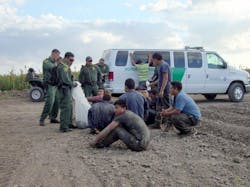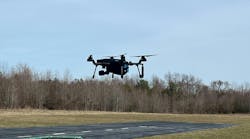MCALLEN, Texas -- He is the Border Patrol division chief responsible for the latest immigration hot spot, and has seen it before. The faces change, he says, and so do the reasons migrants cross into the U.S.
"Historically, these are not high-water-mark numbers -- it's just different populations we're apprehending," Robert Duff explained as he left the U.S. Customs and Border Protection station for a patrol at dusk Thursday.
It wasn't the numbers that made this year's border surge a national crisis as much as the faces: very young, and many came alone.
An estimated 52,000 unaccompanied youths from Central America have been caught along the Southwest's border with Mexico this fiscal year, almost double last year's total. Of that, more than 37,000, nearly triple last year's total, made the crossing into the Rio Grande Valley, putting Duff once again at the epicenter of the immigration battle.
In one sense, Duff, whose piercing blue eyes, shaved head and wrestler's build give him a commanding presence, has moved with the migrants. When he joined the Border Patrol in 1992, he worked the California-Mexico border, where he remembers there being far more people taken into custody, most of them Mexican men. Then tactics changed and the migrants moved east along the Arizona border to try new routes.
Duff moved with the masses, adapting as he went.
Now they have come to McAllen, where Duff has been for two years. Today, it is the busiest station in the country.
About half of those they catch on these patrols are women and children who often turn themselves in, aware that they will be issued notices to appear before immigration officials and allowed to go, Duff said. Migrant children who arrived unaccompanied are held up to 72 hours while their immigration cases are pending.
"But there's still the other half who don't want to get caught," he said as his group of Border Patrol trucks pulled past the Hidalgo border crossing shortly after 6 p.m.
The agents stake out a network of dusty caliche roads along the Rio Grande, hugging the border. The river isn't easy to see, the mesquite brush is high and thick. On the other side, wild hogs dart out of corn and cane fields just as thick and capable of concealing groups of migrants.
Unlike Arizona and California, the land never flattens out, Duff said. High ground with a clear view is scarce. Duff pointed to a Border Patrol portable sky-watch tower -- there are several, paired with aerostat blimps that survey the area. But when it comes to towers, he said, "there's limited places where you can put them where they can be of use. It's a tough place to patrol."
Just then, the truck's radio buzzed with news: Agents working with a local game warden had located a group coming across the south side of the river from Mexico with long guns.
Asked if smugglers use young migrants as decoys, Duff said they often do. Although the Central American groups coming through now are more willing to turn themselves in, he said, agents have been dealing with this kind of tactic for years.
"We don't fall for the ruse that they served a group up and run the drugs through over here," he said, smiling.
Drug activity has decreased recently, according to Duff, but the Rio Grande Valley sector is still second in the nation for drug seizures after Tucson. And despite all the new technology, he said, agents still rely on old-fashioned techniques to locate and flush out migrants: searching for footprints along the dusty roads and other traces that he and other trackers call "cutting for sign."
The radio buzzed again: A group of nine Central American migrants, including several women and children, had turned themselves in. Agents had lined them up where they found them, below the Anzalduas International Bridge along a dirt road dotted with sunflowers that has become a busy spot for apprehensions.
Lorena Flores, 38, a secretary from San Salvador, clutched her 15-year-old son to her as she explained why she fled.
"They killed two of his friends," she said, and her son nodded.
"Who killed them?" one of the agents asked.
MS-13, they said, referring to the transnational gang that tried to recruit her boy.
Flores had heard she might be granted a permiso, permission to stay legally, and paid $4,000 for the two of them to cross and head to connect with her aunt in Houston, leaving her husband behind. She sobbed as a 5-year-old boy from Honduras in Mickey Mouse sneakers watched.
Duff noted that the members of the group were dressed casually -- Flores wore a buttoned-down shirt.
"If it was in Tucson, everyone's got a mochila [knapsack] with them, sardines, geared for a long trek. Here, they're ready to turn themselves in," he said.
More traffic came over the radio: A newly installed camera had alerted agents to another group in a nearby cornfield.
"Groups are used to exploiting these areas," Duff said, gesturing to the fields.
By the time Duff arrived, agents were extracting the group of about a dozen migrants from the cornstalks. Some had to be dragged out, and one, the presumed leader, handcuffed. All were coated in mud. "They were low-crawling it through the fields," Duff said.
There was one woman and no children. Some were from El Salvador and Honduras, but the woman and several others were from Mexico, according to their identification.
"Everyone wants to portray it as they're all giving up," Duff said, "and they're not. We're still having assaults and people getting arrested out here -- it's not all women and children."
Eliazar Delcid, 27, said he fled to the border from Honduras and spent six days crossing without food to get a better job. "I sacrificed everything for my family, to get the money," he said. Back home, he said, he was a corn farmer. His trek ended where it began, in a cornfield, where Duff watched as Delcid and the others were loaded in a Border Patrol van to be taken to the station.
"As soon as they get to our station, they will get a health screening and we'll make sure they get some food," Duff said.
As he returned to the station, Duff said he bristled at reports that immigrants are mistreated by the Border Patrol. His agents make sure those they catch are medically screened, cared for if they are sick, fed and housed safely. Agents routinely buy water to hand out to those they stop, he said. "There's the criminal element," he said, but "these are mostly people fleeing for a better life."
Copyright 2014 - Los Angeles Times
McClatchy-Tribune News Service



